Haeundae District
This article needs additional citations for verification. (September 2021) |
Haeundae
해운대구 | |
|---|---|
| Korean transcription(s) | |
| • Hanja | 海雲臺區 |
| • Revised Romanization | Haeundae-gu |
| • McCune–Reischauer | Haeundae-gu |
 Skyline of Haeundae | |
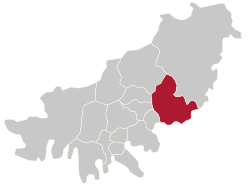 | |
| Country | South Korea |
| Region | Yeongnam |
| Provincial level | Busan |
| Administrative divisions | 18 administrative dong |
| Government | |
| • Mayor | Kim Seong-su (김성수) |
| Area | |
• Total | 51.5 km2 (19.9 sq mi) |
| Population (2024[1]) | |
• Total | 376,621 |
| • Density | 8,226/km2 (21,310/sq mi) |
| • Dialect | Gyeongsang |
| Website | Haeundae District Office |
Haeundae District (Korean: 해운대구; RR: Haeundae-gu) is a district (gu) of Busan, South Korea.
Haeundae has a population of about 423,000, the most populous district of Busan with 11.6% of the city population, and covers an area of 51.44 km² (19.86 sq mi) in eastern Busan.[2] Haeundae became a division of Busan Metropolitan City in 1976 and attained the status of district in 1980.
Haeundae is linked to Busan Subway Line 2 and train stations on the Donghae Nambu railway line.
History
[edit]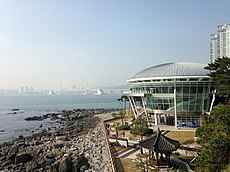
Haeundae takes its name from the ninth century Silla scholar and poet Ch'oe Ch'i-wŏn (literary name Haeun, or "Sea and Clouds"), who, according to a historical account, admired the view from the beach and built a pavilion nearby. A piece of Ch'oe's calligraphy, which he engraved on a rock at Haeundae, still exists.[3] On Haeundae Dongbaek Island, there is a statue of Ch'oe Ch'i-wŏn, a Confucian scholar of the Unified Silla Period, and a monument. During the reign of Queen Jinseong during the Unified Silla Period, Ch'oe Ch'i-wŏn lamented that there was no place to write his studies.
Haeundae used to be isolated from the large communities in Busan and Busanjin. It remained undeveloped until the late 1970s and early 1980s. A small number of luxury hotels were constructed after the 1988 Seoul Olympics.[4] More hotels and other tourist facilities have been constructed on the beach-front area since the mid-1990s, and shopping malls and movie theatre complexes have been built in the 'centre' of Haeundae: an area between Haeundae Station and the beach. The area has continued to grow, apart from during the Asian financial crisis of 1997.
Haeundae has been a regular host of the annual Busan International Film Festival (BIFF). Haeundae's Dongbaek Island was the location for the 2005 APEC Conference.[citation needed]
Haeundae New Town (해운대 신시가지, 海雲臺 新市街地, Haeundae Sinsigaji), a major commercial and residential redevelopment project begun in 1990, is located in the Jwa-dong area. This area lies in the southern shadow of the mountain Jangsan to the north, and is bounded in the south by Haeundae Station on the Dalmaji Gogae line of the Korean National Railroad. Another development project, Centum City, has been ongoing since early 2000 and is now a major feature of Busan. Marine City, located nearby, is constructed on land reclaimed from the sea, and has several huge, high-rise apartment blocks. Additional apartment blocks are under construction, with water resorts and related facilities, for use by the public, also planned for Marine City.[citation needed]
Tourist attractions
[edit]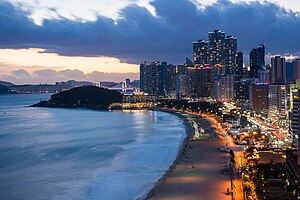
The district contains Haeundae Traditional Market, a large marketplace founded in 1910.[5] It also contains Cheongsapo Daritdol Observatory, an elevated walkway over the sea, where people can look down into the reefs, see the coast, and look to the sunset over the ocean.[6][7] The oldest active restaurant in Haeundae District is the Chinese restaurant Sinheunggwan.[8][9]
Haeundae Dalmaji Hill
[edit]Haeundae's Dalmaji Hill is touted as one of the eight attractions of Busan, and is noted for its scenic view of the moon.[10] Ch'oe Ch'i-wŏn (857-10th century), an official and poet from the late Unified Silla Dynasty (668-935), was so struck by its beauty that he decided to extend his stay there. Some even say that Dalmaji Hill is Busan's answer to Montmartre.[11]
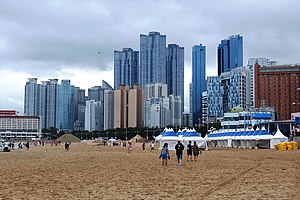
Haeundae Beach
[edit]A beach located in Haeundae District, Busan. Along with Gwangandaegyo Bridge, it is one of Busan's most iconic landmarks, particularly famous among visitors from outside the city. Known as the largest beach in South Korea in terms of size and area, its unique location near the city center and affluent residential skyline makes it one of the most desirable places to live.
Haeundae Beach is regarded as one of the most famous beaches in South Korea.[12]
It serves as a key setting in the movie Haeundae, being the first location hit by the tsunami.
Haeridan-gil Street
[edit]
Previously an old residential neighbourhood, Haeridan-gil (해리단길) has transformed in the last decade into a trendy area where many young locals spend their weekends. The neighbourhood is full of aesthetic cafes, highly rated restaurants and boutiques.[13] Haeridan-gil is located at the top on gunam-ro, behind the old Haeundae Station, across the old Donghae-Nambu line (1905 to 2005).
Film and television
[edit]Haeundae is popular in South Korean media as a setting or filming location. The district was the setting of the movie Haeundae, a South Korean disaster movie scenario of an immense tsunami hitting the city of Busan.[14] Haeundae has been featured in numerous K-Dramas, with the beach and Dongbaekseom being used as a filming location for Seoul Broadcasting System's 2008 drama Star's Lover. The island was the location for the scene where Lee Ma-ri, played by Choi Ji-woo confesses her love for Kim Chul Soo, played by Yoo Ji-tae; and the couple takes a walk on the beach.[15] In 2012, KBS2 broadcast a drama, Haeundae Lovers, using Busan and the district as a backdrop. Much of the story takes place in Cheongsapo, a coastal community in the district east of Haeundae Beach.[citation needed]
Hauendae is home to the Busan Cinema Center, the location of the annual Busan International Film Festival, which features 5 inside theaters and 1 outside theater.[16]
Education
[edit]Haeundae Tourism High School is a private vocational school in the district that specializes in tourism.[17] Founded in 1972, it has a golf course, as well as facilities for the teaching of cooking, baking, bartending, and casino work.[18]
Administrative divisions
[edit]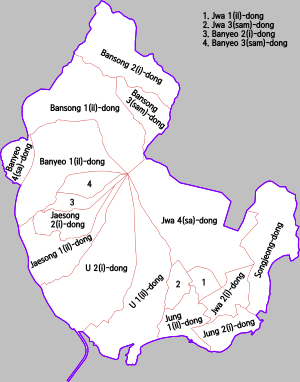
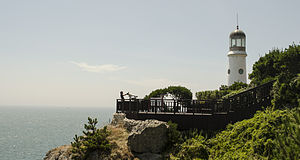
Haeundae District is divided into 7 legal dong, which altogether comprise 18 administrative dong, as follows:
- U-dong (2 administrative dong)
- Jung-dong (2 administrative dong)
- Jwa-dong (4 administrative dong)
- Songjeong-dong
- Banyeo-dong (4 administrative dong)
- Bansong-dong (3 administrative dong)
- Jaesong-dong (2 administrative dong)
Notable people
[edit]- Jeung Eun-ji (Singer, Apink)
- An Jae Mo (Actor)
- Kang Seung-yoon (Singer, WINNER)
- Park Ji-won (Singer, fromis 9)
Gallery
[edit]-
Marine City Night View
-
Gwangan Bridge and Marine City
-
Songjeong Beach
See also
[edit]References
[edit]- ^ "Population statistics". Korea Ministry of the Interior and Safety. 2024.
- ^ 매력있는 세계일류도시 "해운대"로 오세요! Archived 2005-02-10 at the Wayback Machine
- ^ "Haeundae District Office". Archived from the original on 2005-11-19.
- ^ "Famous Haeundae Beach of Busan" Retrieved October 11, 2019
- ^ 정, 희완. 해운대 시장. Encyclopedia of Korean Local Culture. Retrieved 2024-08-09.
- ^ 임, 순택 (2024-07-21). 부산 해운대구, 해월전망대·청사포 다릿돌전망대 준공. 헤럴드경제 (in Korean). Retrieved 2024-08-09.
- ^ "Cheongsapo Daritdol Observatory (청사포 다릿돌전망대)". VisitKorea.or.kr. Retrieved 2024-08-09.
- ^ 박, 상현 (2011-03-24). [부산의 老鋪] ③ 신흥관. Busan Ilbo (in Korean). Retrieved 2024-08-16.
- ^ 박, 주연. 부산역사문화대전. Encyclopedia of Korean Local Culture. Retrieved 2024-08-17.
- ^ "Dalmaji-gil Road (해운대 달맞이길)" Retrieved October 11, 2019
- ^ "Dalmaji-gil Road (해운대 달맞이길)" Retrieved October 11, 2019
- ^ "Haeundae Beach (해운대해수욕장)" Retrieved October 11, 2019
- ^ Reilly, Tara Oh (2024-08-29). "Guide To Haeridan-gil Street, Over The Railway To Haeundae's Trendy Foodie Hotspot". Tara Oh Reilly. Retrieved 2025-01-04.
- ^ "Tsunamis in South Korea". Worlddata.info.
- ^ "A Star's Lover". Korean TV Drama. Korea Tourism Organization. Archived from the original on 18 May 2015. Retrieved 30 May 2012.
- ^ "BUSAN CINEMA CENTER". www.dureraum.org (in Korean). Retrieved 2018-03-16.
- ^ "School Subject". Hauendae Tourism High School. Archived from the original on 30 March 2018. Retrieved 29 March 2018.
- ^ "History". Hauendae Tourism High School. Archived from the original on 30 March 2018. Retrieved 29 March 2018.
External links
[edit]- Haeundae District website Archived 2017-04-08 at the Wayback Machine (in English)
- Haeundae tour website (in English)








